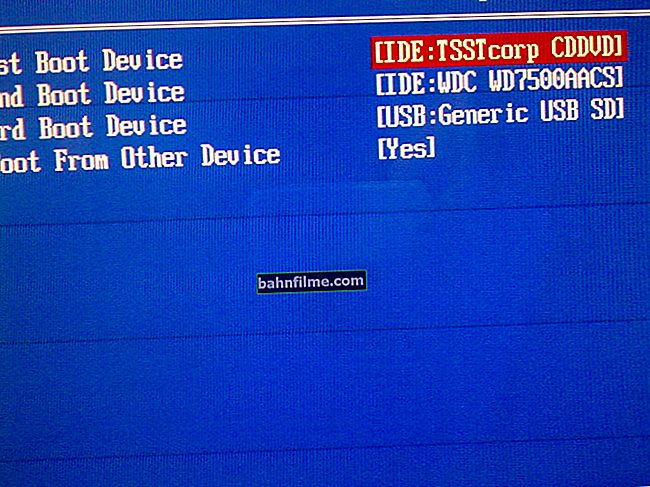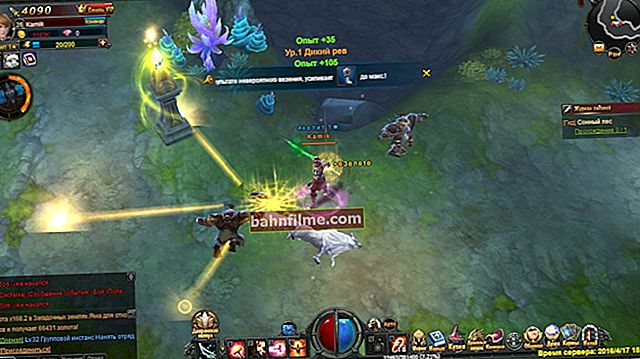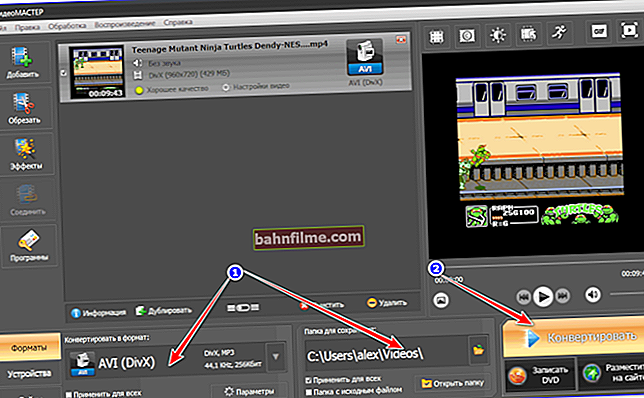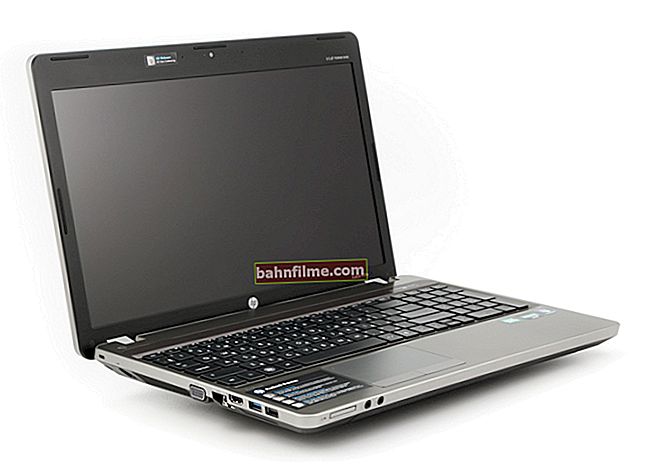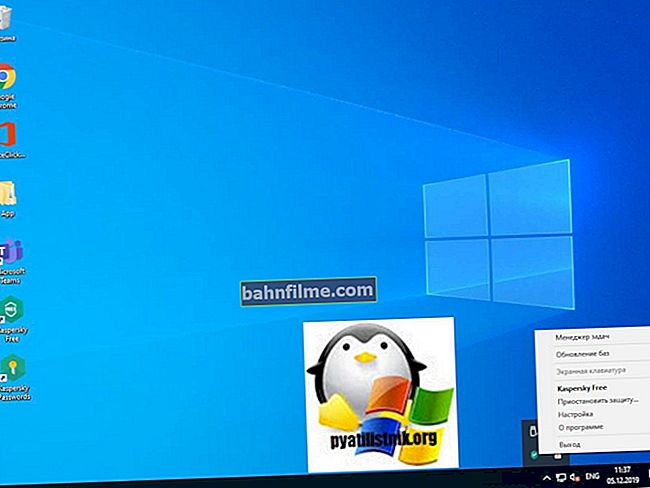 Hello.
Hello.
Users have nicknamed the blue screen the OS kernel error, which suddenly appears (without warning and without allowing them to save documents) and forcing the computer to restart. Moreover, it can occur both on desktop PCs and on laptops (and Windows 10 is no exception, although the system has become much more stable in this regard). See the photo below for an example of an error.
I can't help but note that such a mistake is "insidious", since it is not always easy to find its cause (moreover, it may arise at the stage of OS boot and not allow to fix it).
Be that as it may, in this post I will present some of the most common causes of a blue screen, as well as ways to eliminate them. The note is intended for novice users.
And so, closer to the topic ...

Your PC has a problem and needs to be restarted / An example of a similar error
*
What causes the blue screen and what can be done
❶
For an obvious reason (installing a faulty driver, updating the OS, etc.)
By the obvious, I mean the reason that led to the error immediately after your action (and you noticed it). For example, they installed a new program - a blue screen appeared ⇒ the reason is clear ... 👌 By the way, in more than half of the cases it happens (just not everyone pays attention to it).
It should be noted that most often a blue screen occurs after connecting new equipment and installing a driver on it. This also includes regular driver updates and Windows OS.
Therefore, if after installing a program / driver a similar problem started, just uninstall this software, or replace it with an older version (rollback to the old driver). By the way, most often (according to my observations) the problem occurs when updating the video card driver, and when installing the driver without a digital signature.
How to restore the system
The most reliable option to restore the OS after installing the faulty software is to use recovery point (they are created automatically, however, in different OS versions this option can be enabled or disabled).
To start recovery (universal method):
- press combination Win + R;
- enter the command in the window that appearsrstrui and click OK.

rstrui - start recovery
Next, the system restore function should start and a window with restore points will appear in front of you (pay attention to the dates when they were created and after which programs were installed). In my case, there are three restore points (see screenshot below).
In general, if there are restore points, just roll back the system to one of them, and the problem in most cases is resolved on this ...

Choosing a restore point
What to do if there is no restore point:
- try to manually remove software that was recently installed;
- if this does not work in normal mode, boot the system in safe mode and repeat the operation;
- use the recommendations of the instructions for recovering Windows 10.
How to roll back to an old driver
1) First you need to open the device manager.
2) Next, find the device for which you want to roll back the driver (in my example, I selected the video adapter), and open it properties .

Video adapter properties
3) Then go to the tab "Driver" and click on the button "Roll back" .

Roll back
❷
If the reason is not obvious: the error occurred suddenly
When a blue screen appears suddenly and there is no obvious reason - it's not always so easy to deal with it ...
To get started, I recommend taking a photo (or writing down) the error code, problem file, etc. (see my examples below). This error code (or a specific problem file) - can very significantly narrow the range of problems (and sometimes directly point to it).

Error example

VIDEO TDR FAILURE
If you did not have time to shoot the error, then there is a special.BlueScreenView utility that allows you to view a dump in Windows and find all the latest blue screen errors.

BlueScreenView - utility window screen
Then, knowing the error code, try using specialized sites and find the cause of the problem by it:
- bsodstop.ru/kod-bsod
- allerrorcodes.ru
Note that on the same bsodstop.ru you can get not only the probable cause, but also its solution. At least, I recommend starting with this problem ...

Reason, solution
If the error code does not return anything, try a few diagnostic steps.
❸
If the blue screen prevents Windows from loading
Note: i.e. it appears immediately when Windows starts loading (before the desktop appears).
This blue screen variant is the most insidious as it is. an unprepared user gets the feeling that "the system is dead" and nothing can be done about it ... 👀
What can you advise:
1) After 2-3 unsuccessful downloads with the appearance of critical errors - in most cases, a window appears with a proposal to restore the device. If the cause of the errors is related to some recently installed software, I recommend booting into safe mode and uninstalling it.
You can also try to run System Restore from here (it's important if you have a restore point, more on that below).

Safe mode
To help!
How to enter Safe Mode || Windows 7 ÷ 10 - //ocomp.info/kak-zayti-v-bez-rezh-windows.html
2) If the recovery window does not appear, you can boot the PC / laptop using the installation flash drive (how to do it). Of course, it's ideal if you already have it (or have a second PC on which you can quickly create it).
Note: to boot a PC / laptop from a USB flash drive - you need to use the Boot Menu ...
Further, when the first window with the installation proposal appears, just click in the corner of the screen on the link "System Restore" .

Windows 10 - start installation
Next, go to the menu: "Diagnostics / Additional parameters / System restore" .

System Restore / Windows 10
After that, a wizard should start, which will help you roll back the system to a previous working state (if there are restore points).

Recovery start
You may also need to restore OS boot records (link below for help).
Instructions!

Restoring Windows 10 boot records - //ocomp.info/vosstanovlenie-windows-10.html#i-4
3) Try resetting BIOS settings.
4) Try to install another Windows OS on the disk (or reinstall the old one).
5) If the previous one does not help, there may be a problem in the hardware. Try to disconnect everything from your PC / laptop (to a minimum): printers, scanners, USB adapters, add. monitors, etc.
I also recommend that you pay attention to the RAM, try to leave only one bar (if you have 2/3 of them), install it one by one and check its operation in different slots (it would not be superfluous to test it using a special utility).
❹
If an error appears in the game
1) Reinstall the drivers (especially on the video card). Download them from the official website of your device manufacturer.
If possible, try using a different OS with an older / newer version of the video driver.
To help!
How to install a second Windows to disk without losing data - //ocomp.info/kak-ustanovit-vtoruyu-windows.html
How to properly reinstall the driver on the video card - //ocomp.info/kak-obnovit-drayver-na-videokartu.html
2) Check the game files with an antivirus, try reinstalling it. Change the graphics settings (turn off fog, fine particles, vertical sync, various filters, etc.).
To help!
Scanning files and systems for viruses - //ocomp.info/esli-antivirus-ne-vidit-virusov.html
3) Stress test the video card, view its temperatures, check if it is overheating.
4) Disable (uninstall) various utilities to speed up games, view for FPS, etc.
❺
Diagnostics: what to check
Temperatures of CPU, video card
In games, editors (and other resource-intensive programs), the temperature of the CPU and video card can rise significantly. Of course, if the temperature goes beyond certain limits, this can lead to various errors (including a blue screen).
Note: the CPU has a certain temperature threshold, upon reaching which, the computer will simply turn off / restart (protection against failure will work).
To view the temperature, specials are most often used. utilities (for example, AIDA 64). Of course, you need to watch the temperature in dynamics: i.e. run the utility immediately after Windows boots, and then start your usual work at the PC (from time to time looking at the sensors, especially when you hear the growing hum of coolers).

AIDA64 - viewing temperature (sensors tab)
Note: for AIDA 64 temperature sensors can be displayed in the tray (next to the clock) in Windows. Thus, you do not have to minimize / maximize the utility window every time.
If the temperature is outside the optimal range * - try a number of measures: clean the device from dust, adjust the power settings, replace the thermal paste, etc.
In general, of course, a stress test allows you to more effectively check the state of the computer's hardware (this is when a special program "artificially" creates a high load). More on that below ...
* To help!

Intel processor temperature: how to find it; which is considered normal and which is overheating - //ocomp.info/temperatura-protsessora-intel.html
Stress test (how the equipment behaves under load)
A stress test allows you to find out the real frequency of the CPU and video card, their temperatures, check the stability of the system, find out about all the weak points of the PC / laptop. Often, a stress test is the only way to get to the bottom of the cause of an unstable device.
You can perform a stress test in various programs and utilities (depending on what you are testing). I have instructions on my blog on how to perform a similar test in AIDA 64 - I recommend it!
Instructions!
How to perform a stress test of the processor and the system as a whole, does it hold frequencies, is there overheating (AIDA 64) - //ocomp.info/kak-vyipolnit-stress-test-videokartyi-noutbuka-v-aida-64.html

CPU frequency / AIDA 64
As for the video card itself, for testing it, in addition to AIDA 64, we can recommend the OCCT and FurMark utilities (by the way, they will also help evaluate its real performance). How to work with them - see the instructions, the link to which is below.

Live Test Results / OCCT Utility
To help!

Video card stress test: checking for reliability and stability - //ocomp.info/stress-test-videokartyi.html
Testing RAM strips
If a blue screen occurs spontaneously, regardless of the running and installed programs, some actions on the PC, it is possible that the reason for this is the RAM bar. And if the reason for critical errors is not clear, it is recommended to subject them to testing ...
This can be done using the Windows tool (click Win + R , and use the command mdsched) and an independent utility (Memtest 86+). Of course, I would recommend using the second option ...
Instructions!
RAM test: checking RAM for errors - //ocomp.info/testirovanie-operativnoy-pamyati-test-ozu-ram.html

Memory problems / Memtest 86+ utility
By the way, I would also recommend cleaning the contacts of the strips with an elastic band and a brush (it would not be superfluous to blow the connectors on the motherboard). If you use several brackets, try starting the computer with one (it is possible that because of one of the brackets (or a slot) a blue screen pops up ...).
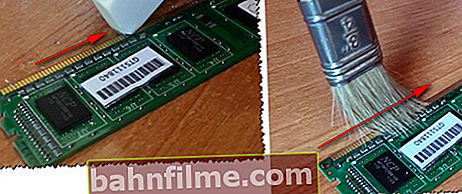
Cleaning memory contacts with an eraser and a brush
Reset BIOS settings
There are a number of settings in the BIOS that, if changed, may cause your computer to stop working stably. For example, one of the options is to change the drive mode (AHCI, IDE) or change the boot priority.
It is worth noting that such parameters are not always changed manually - a change may occur due to a dead battery or a jump in the power supply circuits (in this case, the BIOS firmware may "disappear" (you will immediately understand this, since the device will stop turning on at all!) and it will be possible to restore it only in the service on the programmer).
To help!

How to reset BIOS settings - //ocomp.info/kak-sbrosit-nastroyki-bios.html
*
Additions on the topic are welcome ...
Good luck!
👋
